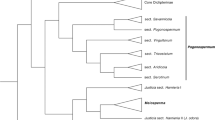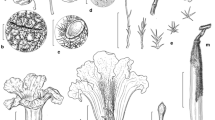Abstract
Seeds of theHordeum patagonicum complex were collected from the field and grown in the greenhouse. The aim was to take a sample of members of the complex, and on the basis of the phenotypic similarities in some morphological and physiological characters, determine whether distinct groups exist. When cluster analyses, to generate hypotheses, and orthodox statistical procedures, for hypotheses obtained a priori, were applied to the reproductive morphology, germination and flowering patterns, onlyH. patagonicum subsp.magellanicum, out of the five recognized taxa, could be distinguished consistently. The remaining four taxa, which overlapped considerably, could be re-formed into three groups whose centroids were different but whose ranges of variation were not distinct from each other. We conclude that the highly cross-compatible members of theH. patagonicum complex, first defined as species and later redefined as subspecies are probably no more than biotypes.
Similar content being viewed by others
References
Bothmer, R. von, Jacobsen, N., 1979: Biosystematic investigations in the genusHordeum. — Proc. Conf. Broadening Genet. Base Crops, 60Wageningen, 1978. — Wageningen: Pudoc.
Bothmer, R. von, Giles, B. E., Jacobsen, N., 1986: Crosses and genome relationship in theHordeum patagonicum group. — Genetica71: 75–80.
—, 1988: Taxonomy and variation in theHordeum patagonicum group. — Bot. Jahrb. Syst.109: 373–384.
Bradshaw, A. D., 1972: Some of the evolutionary consequences of being a plant. — Evol. Biol.5: 25–47.
Gower, J. C., 1966: Some distance properties of latent root and vector methods used in multivariate analysis. — Biometrica53: 523–338.
—, 1971: A general coefficient of similarity and some of its properties. — Biometrics27: 857–871.
Lefkovitch, L. P., 1976: Hierarchical clustering from principal coordinates: an efficient method for small to very large numbers of objects. — Math. Biosci.31: 157–174.
—, 1982: Conditional clusters, musters, and probability. — Math. Biosci.60: 207–234.
—, 1984: A nonparametric method for comparing dissimilarity matrices, a general measure of biogeographical distance, and their application. — Amer. Naturalist123: 484–499.
—, 1985: Further nonparametric tests for comparing dissimilarity matrices based on the relative neighborhood graph. — Math. Biosci.73: 71–88.
—, 1987: Clustering from ordination. — Math. Biosci.87: 17–30.
Levin, D. A., 1979: The nature of plant species. — Science204: 381–384.
Madsen, K., Nielsen, E. S., Ødum, S., 1980: The Danish scientific expedition to Patagonia and Tierra del Fuego 1978–1979. — Geografisk Tidsskrift80: 1–28.
McCullagh, P., Nelder, J. A., 1983: Generalized linear models. — London: Chapman & Hall.
Nicora, E., 1978:Gramineae. — InCorrea, M. N., (Ed.): Flora Patagonia,7, 3, pp. 1–580. — Buenos Aires: INTA.
Prentice, H. C., 1986: Continuous variation and classification. — InStyles, B. T., (Ed.): Infraspecific classification of wild and cultivated plants. The Systematics Association Special Volume29. — Oxford: Clarendon Press.
Author information
Authors and Affiliations
Rights and permissions
About this article
Cite this article
Giles, B.E., Lefkovitch, L.P. Subgroups in theHordeum patagonicum complex (Poaceae). Pl Syst Evol 174, 47–66 (1991). https://doi.org/10.1007/BF00937693
Received:
Revised:
Accepted:
Issue Date:
DOI: https://doi.org/10.1007/BF00937693




